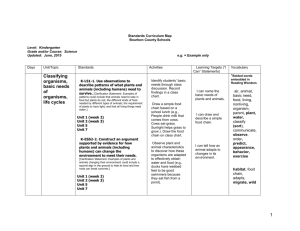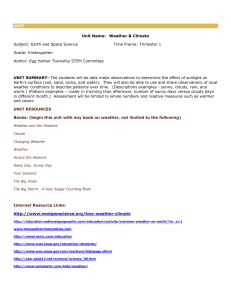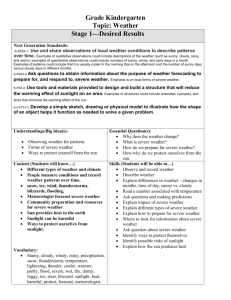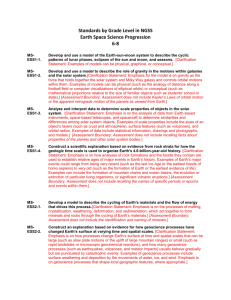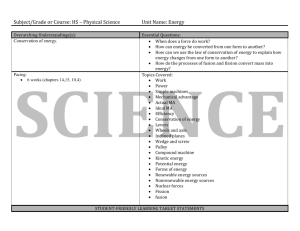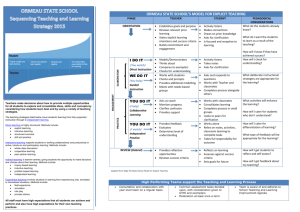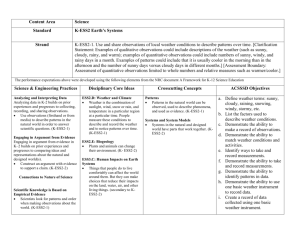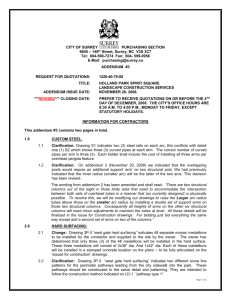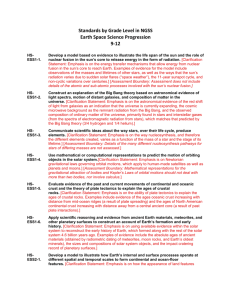Perry County Schools Grade K Science Pacing Guide
advertisement
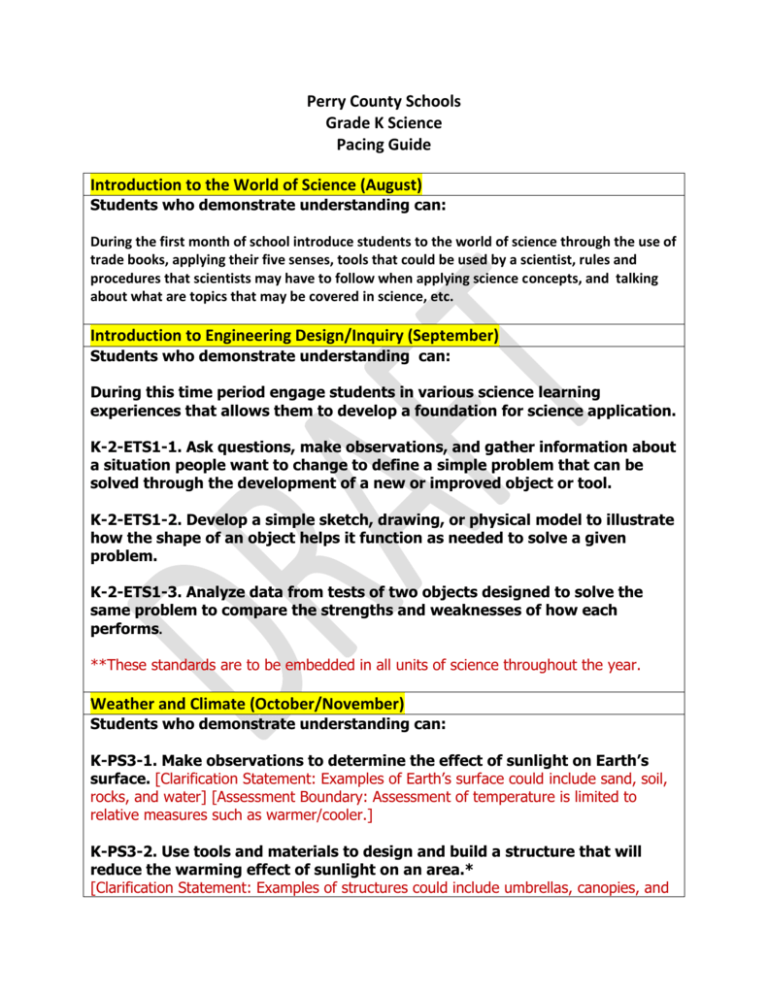
Perry County Schools Grade K Science Pacing Guide Introduction to the World of Science (August) Students who demonstrate understanding can: During the first month of school introduce students to the world of science through the use of trade books, applying their five senses, tools that could be used by a scientist, rules and procedures that scientists may have to follow when applying science concepts, and talking about what are topics that may be covered in science, etc. Introduction to Engineering Design/Inquiry (September) Students who demonstrate understanding can: During this time period engage students in various science learning experiences that allows them to develop a foundation for science application. K-2-ETS1-1. Ask questions, make observations, and gather information about a situation people want to change to define a simple problem that can be solved through the development of a new or improved object or tool. K-2-ETS1-2. Develop a simple sketch, drawing, or physical model to illustrate how the shape of an object helps it function as needed to solve a given problem. K-2-ETS1-3. Analyze data from tests of two objects designed to solve the same problem to compare the strengths and weaknesses of how each performs. **These standards are to be embedded in all units of science throughout the year. Weather and Climate (October/November) Students who demonstrate understanding can: K-PS3-1. Make observations to determine the effect of sunlight on Earth’s surface. [Clarification Statement: Examples of Earth’s surface could include sand, soil, rocks, and water] [Assessment Boundary: Assessment of temperature is limited to relative measures such as warmer/cooler.] K-PS3-2. Use tools and materials to design and build a structure that will reduce the warming effect of sunlight on an area.* [Clarification Statement: Examples of structures could include umbrellas, canopies, and tents that minimize the warming effect of the sun.] K-ESS2-1. Use and share observations of local weather conditions to describe patterns over time. [Clarification Statement: Examples of qualitative observations could include descriptions of the weather (such as sunny, cloudy, rainy, and warm); examples of quantitative observations could include numbers of sunny, windy, and rainy days in a month. Examples of patterns could include that it is usually cooler in the morning than in the afternoon and the number of sunny days versus cloudy days in different months.] [Assessment Boundary: Assessment of quantitative observations limited to whole numbers and relative measures such as warmer/cooler.] K-ESS3-2. Ask questions to obtain information about the purpose of weather forecasting to prepare for, and respond to, severe weather.* [Clarification Statement: Emphasis is on local forms of severe weather.] Forces and Interactions: Pushes and Pulls (December/January) Students who demonstrate understanding can: K-PS2-1. Plan and conduct an investigation to compare the effects of different strengths or different directions of pushes and pulls on the motion of an object. [Clarification Statement: Examples of pushes or pulls could include a string attached to an object being pulled, a person pushing an object, a person stopping a rolling ball, and two objects colliding and pushing on each other.] [Assessment Boundary: Assessment is limited to different relative strengths or different directions, but not both at the same time. Assessment does not include non-contact pushes or pulls such as those produced by magnets.] K-PS2-2. Analyze data to determine if a design solution works as intended to change the speed or direction of an object with a push or a pull.* [Clarification Statement: Examples of problems requiring a solution could include having a marble or other object move a certain distance, follow a particular path, and knock down other objects. Examples of solutions could include tools such as a ramp to increase the speed of the object and a structure that would cause an object such as a marble or ball to turn.] [Assessment Boundary: Assessment does not include friction as a mechanism for change in speed.] Interdependent Relationships in Ecosystems: Animals, Plants, and their Environment (February/March) Students who demonstrate understanding can: K-LS1-1. Use observations to describe patterns of what plants and animals (including humans) need to survive. [Clarification Statement: Examples of patterns could include that animals need to take in food but plants do not; the different kinds of food needed by different types of animals; the requirement of plants to have light; and that all living things need water.] K-ESS2-2. Construct an argument supported by evidence for how plants and animals (including humans) can change the environment to meet their needs. [Clarification Statement: Examples of plants and animals changing their environment could include a squirrel digs in the ground to hide its food and tree roots can break concrete.] K-ESS3-1. Use a model to represent the relationship between the needs of different plants or animals (including humans) and the places they live. [Clarification Statement: Examples of relationships could include that deer eat buds and leaves, therefore, they usually live in forested areas, and grasses need sunlight so they often grow in meadows. Plants, animals, and their surroundings make up a system.] K-ESS3-3. Communicate solutions that will reduce the impact of humans on the land, water, air, and/or other living things in the local environment.* [Clarification Statement: Examples of human impact on the land could include cutting trees to produce paper and using resources to produce bottles. Examples of solutions could include reusing paper and recycling cans and bottles.] Choice of Science Topics/Careers in Science (April/May) During this time period cover any other science related topic of choice, apply the Engineering Designs into units of study, cover science related career choices through trade books, websites, etc. Review or complete any science content not completed during the school year. Testing Window ( 2 Weeks) Revised May 27, 2014
